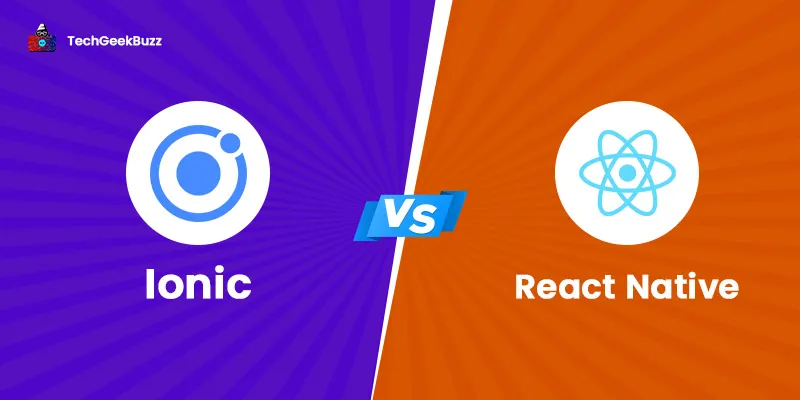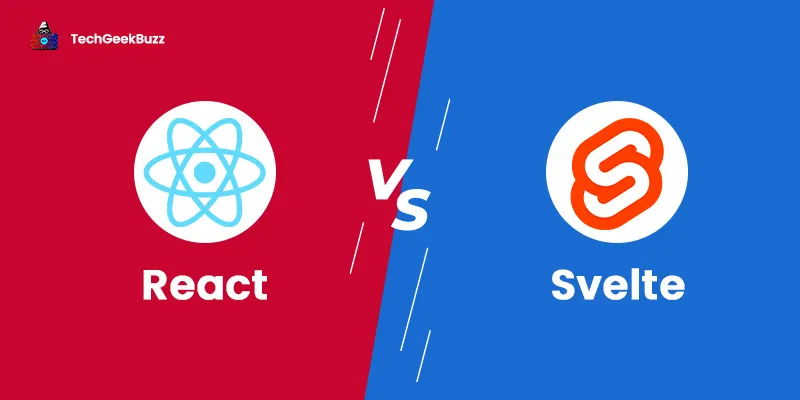When you think of developing cross-platform mobile applications, a galore of frameworks and libraries are available out there. As a result, you may get perplexed in choosing the one that best suits your needs. Some popular frameworks for mobile app development are Xamarin, Flutter, Apache Cordova, React Native, and Ionic.
Among all, two prominent players in the mobile app development market are React Native and Ionic. Both Ionic and React Native are open-source and have strong community support. While Ionic lets you build hybrid applications, React Native allows you to develop native-like applications for Android and iOS.
With the aim of making it easier for you to choose between Ionic and React Native, we have created this blog post that highlights all the major differences between Ionic and React Native. Also, it walks you through the features, upsides, and downsides of Ionic and React Native.
So, let us get started without wasting time!
What is Ionic?
Ionic is an open-source UI framework for developing cross-platform mobile applications. This framework lets you build applications native to Android and iOS platforms.
Besides mobile applications, this framework supports the development of progressive web applications as well as desktop applications. For progressive web applications, it lets you leverage three core technologies of the World Wide Web (WWW), namely JavaScript, HTML, and CSS.
Moreover, this framework is primarily concerned with the front-end or user interfaces of applications, i.e., it handles the structure and appearance of your applications. It comes with reusable UI components that serve as building blocks and facilitate the creation of your application’s UI.
One of the most desirable benefits of the Ionic framework is that it lets you write the codebase only once and use the same for developing applications for various operating systems.
History
Drifty Co. created the alpha version of the Ionic framework in November 2013. In the following year, the beta version of Ionic or Ionic 1.0 was released, which was compatible with Angular 1 and supported Angular components.
Further, the year 2016 witnessed the release of Ionic 2.0, which was compatible with Angular 2. This version provided the same functionality that its previous version provided. However, Ionic 2 only supported Angular 2 applications.
Later, Ionic 3 came into existence in 2017 with a lot of added functionality to version 1 and version 2. However, it was compatible with Angular 4 and supported the applications developed using it.
Ionic 4, released in 2019, was the first version that was based on web components. It enabled users to create progressive web applications and native mobile applications. It was not just limited to Angular. Instead, it was compatible with many other frameworks.
The latest and stable version of Ionic is Ionic 5, released in 2020, with improved UI components. Like Ionic 4, this version also supported many other frameworks, including Angular, React and Vue . Besides this, it allows developers to design custom components and animations.
Features
Here are the notable features of Ionic:
- Platform Independent: Ionic applications run on various platforms, including Android and iOS, irrespective of the platform you use for developing applications. In other words, you can build Ionic applications that work on various platforms with a single codebase.
- Web Standards-Based: The ionic framework is built using all three core web technologies, namely HTML, CSS, and JavaScript.
- Based on Angular: Ionic is based on Angular, which is a popular framework when it comes to web and mobile app development. When you use Ionic with Angular, you can add more attractive components to your application.
- Cordova Plugin: Ionic supports Cordova plugins that provide a JavaScript interface to native components. These plugins let your application use native device functionalities.
- Ionic CLI: Ionic Command Line Interface is a tool that lets you run various Ionic commands for starting, running, or emulating Ionic applications.
- Capacitor: It is a cross-platform API that enables you to use web code to call native SDKs.
- Stencil: Ionic created a new web component compiler called stencil that helps developers build standards that conforms to a web server.
Advantages
The following are the major upsides of Ionic:
- Ionic is freely available and is faster and more reliable.
- It comes with a wide range of plugin support, which makes it easier to develop robust mobile applications.
- With Angular as its base, Ionic has a wide community of active developers who contribute their knowledge and help you get out the problems that you encounter during development.
- Testing Ionic applications is pretty easy. This framework lets you test your applications in a browser or through simulator testing for all OS.
- Applications developed in ionic ensure fast speed and compatibility with the latest platforms.
- It lets you create interactive and appealing UI effortlessly.
Disadvantages
The following are some of the significant pitfalls of Ionic:
- It consumes a lot of time to debug an Ionic application.
- Many times, you experience build crashes for no reason. This is because there may be something corrupted in the original folder.
- Ionic does not support hot reloading.
- Ionic applications may offer slow performance in comparison to native applications.
- You need to depend on plugins to add native functionalities to your application.
- It is not ideal for developing video games or applications that require high-end graphics.
What is React Native?
React Native, also referred to as RN, is one of the most prominent UI frameworks for building native mobile applications for iOS and Android platforms. Using a single codebase, this framework lets you build mobile applications for both Android and iOS.
With the React library as the basis, Meta (formerly Facebook) developed React Native, which today became the most popular solution for mobile app development. React is a Meta’s UI library based on JavaScript that makes it painless for developers to create intuitive user interfaces.
You will find a number of built-in components in React Native that you can readily combine and create an appealing user interface for your application. Moreover, React Native leverages JSX (JavaScript Syntax Extension), a combination of JavaScript and XML-esque markup, to develop mobile applications.
Many popular websites and applications, including Facebook, Instagram, Flipkart, Shopify, and Pinterest, are powered by React Native.
History
When Meta decided to bring its service, i.e., Facebook, to mobile devices, it did not develop a dedicated application as we have today. Instead, they created a webpage based on HTML5 to make their service run on mobile devices. However, this service required a lot of performance enhancement.
Later, in 2013, Jordan Walke, a developer at Meta, discovered a method of creating UI elements for iOS applications by leveraging JavaScript. Later, the company conducted a Hackathon to discover the potential of JavaScript for mobile development. The result of this Hackathon turned out to into the development of React Native.
Initially, it was created only for iOS applications. However, the company quickly updated it to provide support for Android applications. Finally, in 2015, Meta released React Native publicly.
Features
The following are the salient features of React Native:
- Write Once, Use Anywhere: This feature lets you write code only once and use it to create applications for Android and iOS platforms. There is no need to write separate codebases for different platforms. As a result, React Native is a perfect framework for hybrid app development.
- UI-Focused: React Native is a UI-focused framework since it concentrates a lot on designing the UI of mobile applications. It comes with excellent rendering capabilities.
- Live Reload: The live reload feature lets you see the changes in real-time as soon as you make changes to the source code. While working with React Native, your screen gets divided into two panels. The first panel is where you write the source code, and the second is where you can see the changes in real-time.
- Reusable Components: This framework comes with a comprehensive library of components. You can reuse these components of React Native that serve as building blocks. Components reusability saves significant time and effort in creating components from scratch.
- Hot Reload: This feature allows you to change the changes you make to the code base without reloading the entire application. Once you make changes, you just need to save them. Later, React Native identifies all the files that have changed since you saved them and reloads only those files.
- Programming Language: The popularity of a framework significantly depends on the programming language it uses. If it uses a popular programming language, people are more likely to use it. React Native leverages JavaScript, which is the highly preferred language for web development. It is one of the core technologies of the World Wide Web (WWW).
Advantages
The following are the remarkable advantages of React Native:
- This framework significantly reduces the development time required to build responsive and native-like mobile applications.
- Backed by Meta, Ionic is one of the most trusted platforms for building cross-platform mobile applications.
- React Native supports various third-party libraries through which you can extend its functionality.
- It uses the Node Package Manager (NPM), making it easier to install the framework on your system.
- Since it is one of the most preferred platforms in the mobile app development industry, it has a community of active developers that contribute from across the globe.
- It is an open-source framework, and hence, anyone can use it freely.
- It is a cost-effective solution for mobile app development.
- React Native also provides access to debugging and error reporting tools.
Disadvantages
Some major downsides of React Native are as follows:
- As this framework is open-source, there is a lack of security. Therefore, when your application requires a lot of security, like that of any banking or financial application, React Native is not ideal.
- If you use the hot reload feature consecutively, you may get into a mess.
- React Native does not offer excellent support for custom modules.
- It does not support multi-threading and multi-processing.
- The performance of applications developed in React Native is relatively lower than native apps.
- Updating React Native to the latest version is quite a complicated process.
Ionic vs React Native - A Head-to-Head Comparison
The following table highlights the major differences between Ionic and React Native:
|
Parameters |
Ionic |
React Native |
|
Definition |
Ionic is an open-source UI framework developed by Drifty Co. for building mobile applications, desktop applications, and progressive web applications. |
React Native is an open-source framework developed by Meta for building native-like applications for Android and iOS platforms. |
|
Based on |
The Angular framework and core web technologies (HTML, CSS, and JavaScript) form the basis for Ionic. |
Meta’s popular JavaScript-based UI library, React, forms the basis for React Native. |
|
Application Development |
Ionic lets you create hybrid applications using HTML, CSS, and JavaScript that can run on mobile devices, desktops, and the web. |
React Native helps you build truly native mobile applications for Android and iOS. |
|
Technology Stack |
The technology stack of Ionic is relatively more flexible than React Native. From Ionic 4 onward, it lets you work with any web framework, including React, Vue.js, and Angular. |
It is a JavaScript-based framework. In addition, all the UI components are developed in JSX (JavaScript Syntax Extension). |
|
Performance |
Since Ionic develops hybrid applications, you may encounter performance issues. |
Applications developed in React Native are highly performant and responsive. |
|
Testing |
Ionic supports testing in a browser or through the testing simulator. |
React Native essentially requires a device or simulator for testing applications. |
|
Used by |
Some popular companies that use Ionic are Southwest Airlines, Airbus Helicopters, Electronic Arts, and National Health Service. |
Facebook, Instagram, Microsoft, Pinterest, Hike, and Yahoo leverage React Native. |
Ionic vs React Native - Which One is Right to Choose?
Now that we know what sets Ionic and React Native apart, we can conclude that Ionic is a perfect framework for building hybrid applications, i.e., applications that run on the web, desktops, and mobile devices. Meanwhile, React Native is ideal for building native-like mobile applications for Android and iOS platforms.
As a result, declaring one framework superior to the other would be unfair. The ultimate decision between ionic and React Native depends on the project requirements. So, choose the framework that meets your project needs.
Conclusion
Here, we have reached the end of our discussion on the differences between Ionic and React Native. Choose Ionic if your mobile application is centered around the idea of mission-critical applications, progressive web applications, or enterprise-level applications. On the flip side, if you want to build mobile applications that provide native experiences targeting Android and iOS platforms, choosing React Native would be a wise decision.
Do let us know the framework you have chosen for cross-platform mobile application development via the comments section.
People are also reading:





Leave a Comment on this Post